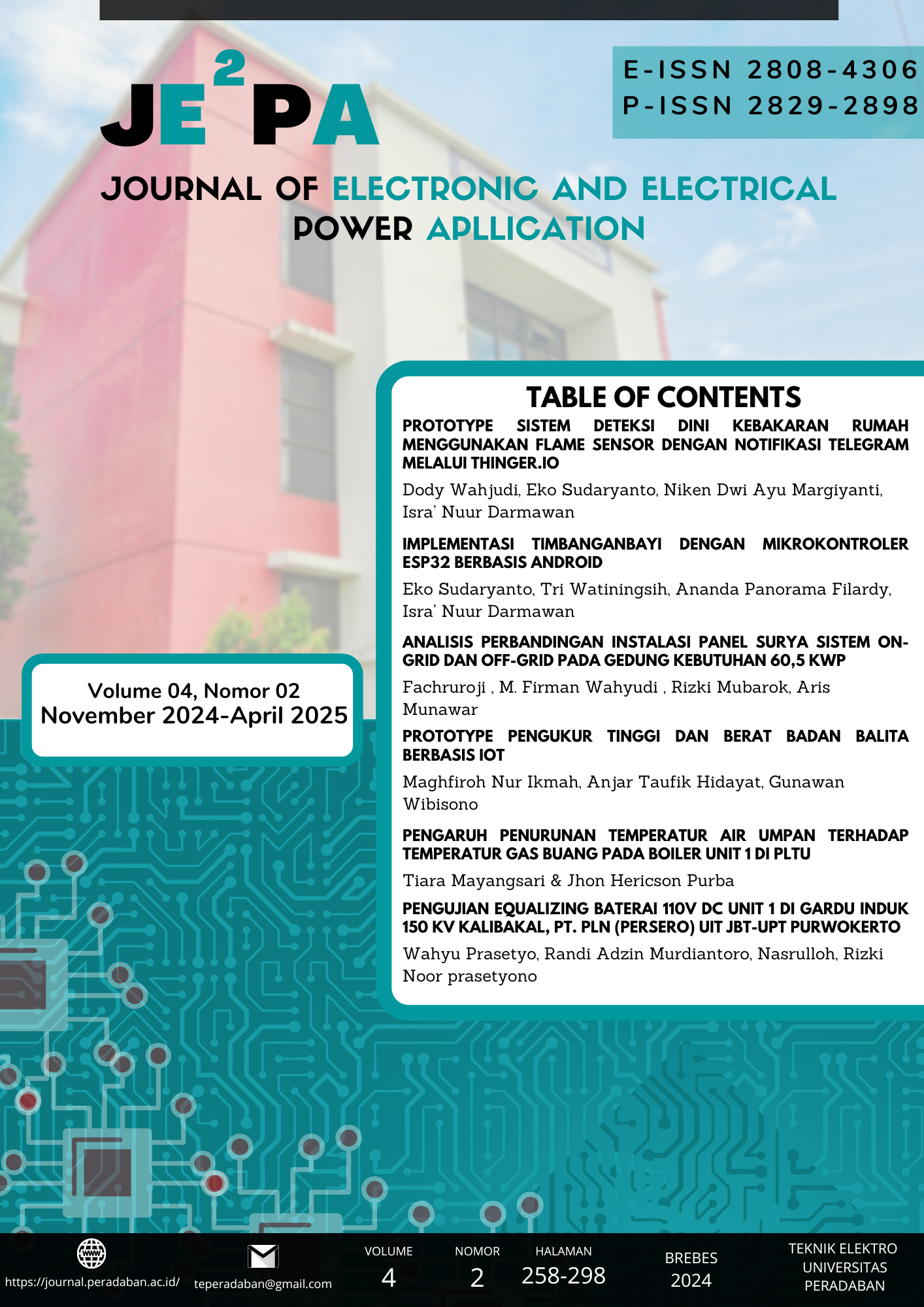PROTOTYPE OF HOUSE FIRE EARLY DETECTION SYSTEM USING FLAME SENSOR WITH TELEGRAM NOTIFICATION VIA THINGER.IO
DOI:
https://doi.org/10.58436/jeepa.v4i2.2020Keywords:
Fire Detection , IoT, Flame Sensor, MQ-2 Sensor , Dust SensorAbstract
This research is based on the problem of gas leakage which is one of the factors causing fires to occur. Too slow a response of the homeowner to the occurrence of a fire disaster is a factor in fires that can cause loss of life and property that is not small. As an effort to prevent things that are not expected, a system that can detect fires effectively is needed. Designing a fire detection system that supports IoT (Internet Of Things) so that it can be monitored remotely is a suitable preventive alternative. Therefore, the design of a fire detection system using the NodeMCU ESP8266 microcontroller and input Flame sensor that can detect the presence of fire with a minimum detection distance of 10cm with an average voltage output of 5.076V while, the maximum detection distance is 100cm with an average voltage output of 5.066V. MQ-2 sensor to detect gas particles with an average output voltage of 4.99V. Dust sensors can detect paper smoke particles with an average voltage output of 5.066V at a smoke density of 848.90 while cigarette smoke with an average voltage output of 5.038 at a smoke density of 849.87. If one of the sensors detects a potential fire, it will automatically send a message to Telegram accompanied by a buzzer and LED that lights up as a warning sign. Thinger.io software to monitor data changes in the system.
References
D. Sistem, D. Asap, B. Sensor, and M. Iot, “Desain Sistem Deteksi Asap dan Api Berbasis Sensor, Mikrokontroler dan,” vol. 6, no. 1, pp. 117–127, 2020.
H. D. Cahyadi, Y. Mirza, E. Laila, D. T. Komputer, P. N. Sriwijaya, and J. S. Negara, “Rancang Bangun Alat Pendeteksi Kebakaran Menggunakan Flame Sensor dan Sensor Asap Berbasis Arduino,” vol. 2, no. 1, pp. 60–69, 2022.
F. A. Setiawan, “Sistem Pendeteksi Kebakaran Multi Sensor Berbasis Iot Pada Bengkel Listrik Di BLK Cilacap,” 2021.
Nizam, Muhammad Nizam, Haris Yuana, and Zunita Wulansari. "Mikrokontroler Esp 32 Sebagai Alat Monitoring Pintu Berbasis Web." JATI (Jurnal Mahasiswa Teknik Informatika) 6.2 (2022): 767-772.
Rahmanto, Yuri, Anang Burlian, and Slamet Samsugi. "Sistem Kendali Otomatis Pada Akuaponik Berbasis Mikrokontroler Arduino Uno R3." Jurnal Teknologi Dan Sistem Tertanam 2.1 (2021): 1-6.
F. Reverter, M. Gasulla, and S. Member, “LED-based Wake-up Circuit for Microcontrollers,” vol. 9456, no. c, pp. 10–12, 2020, doi: 10.1109/TIM.2020.3009340.
Z. Wan, Y. Song, and Z. Cao, “Environment dynamic monitoring and remote control of greenhouse with ESP8266 NodeMCU,” Proc. 2019 IEEE 3rd Inf. Technol. Networking, Electron. Autom. Control Conf. ITNEC 2019, no. Itnec, pp. 377–382, 2019, doi: 10.1109/ITNEC.2019.8729519.
A. Škraba, A. Kolozvari, D. Kofjac, R. Stojanovic, E. Semenkin, and V. Stanovov, “Prototype of Group Heart Rate Monitoring with ESP32,” 2019 8th Mediterr. Conf. Embed. Comput. MECO 2019 - Proc., no. June, 2019, doi: 10.1109/MECO.2019.8760150.
Wu, Zhenyu, Kai Qiu, and Jianguo Zhang. "A smart microcontroller architecture for the internet of things." Sensors 20.7 (2020): 1821.
J. Zikulnig, S. Lengger, L. Rauter, L. Neumaier, S. Carrara, and J. Kosel, “Sustainable Printed Chitosan-Based Humidity Sensor on Flexible Biocompatible Polymer Substrate,” IEEE Sensors Lett., vol. 6, no. 12, pp. 4–7, 2022, doi: 10.1109/LSENS.2022.3224768.
Butt, Muhammad Ali, Svetlana Nikolaevna Khonina, and Nikolay Lvovich Kazanskiy. "Simple and improved plasmonic sensor configuration established on MIM waveguide for enhanced sensing performance." Plasmonics 17.3 (2022): 1305-1314.
Duan, Zaihua, Yadong Jiang, and Huiling Tai. "Recent advances in humidity sensors for human body related humidity detection." Journal of Materials Chemistry C 9.42 (2021): 14963-14980.
Bestari, Dea Nurina, and Antoni Wibowo. "An IoT-Based Real-Time Weather Monitoring System Using Telegram Bot and Thingsboard Platform." International Journal of Interactive Mobile Technologies 17.6 (2023).
Sutikno, Tole, et al. "Internet of things-based photovoltaics parameter monitoring system using NodeMCU ESP8266." International Journal of Electrical and Computer Engineering 11.6 (2021): 5578-5587.
Macheso, Paul Stone Brown, and Angel G. Meela. "IoT Based Patient Health Monitoring using ESP8266 and Arduino." International journal of computer communication and informatics 3.2 (2021): 75-83.
S. Hadi and A. Adil, “Rancang Bangun Pendeteksi Gas Berbasis Sensor Mq-2,” Semin. Nas. Sist. Inf. Dan Tek. Inform., pp. 327–334, 2019.
R. C. Pandey, M. Verma, and L. K. Sahu, “Internet of Things (IOT) Based Gas Leakage Monitoring and Alerting System with MQ-2 Sensor,” Int. J. Eng. Dev. Res., vol. 5, no. 2, pp. 2321–9939, 2017.
Galceran, Sherwin Johanne D., et al. "Development and Comparison of Arduino Based MQ-2 and MQ-6 LPG Leak Sensors." American Journal of Sensor Technology 7.1 (2023): 1-9.
Daruwati, I., R. G. Hatika, and D. Mardiansyah. "MQ-2 gas sensor using micro controller arduino uno for LPG leakage with short message service as a media information." Journal of Physics: Conference Series. Vol. 2049. No. 1. IOP Publishing, 2021.
Olivares, G., and S. Edwards. "The Outdoor Dust Information Node (ODIN)–development and performance assessment of a low cost ambient dust sensor." Atmospheric Measurement Techniques Discussions 8.7 (2015): 7511-7533.
Cheriyan, Daniel, and Jae-ho Choi. "Estimation of particulate matter exposure to construction workers using low-cost dust sensors." Sustainable Cities and Society 59 (2020): 102197.
Simatupang, Joni Welman, and Bintang Ramadhan Prasetya. "Embedded Smart Glove using Ultrasonic and Flame Sensors for Helping Visually Impaired People." 2021 International Conference on Radar, Antenna, Microwave, Electronics, and Telecommunications (ICRAMET). IEEE, 2021.
D. Darussalam and A. Azwardi, “Penggunaan IR Flame Sensor Sebagai Sistem Pendeteki Api Berbasis Mikrokontroler pada Simulator Fire Suppression System,” Semin. Nas. Tek. Mesin, vol. 9, no. 1, pp. 603–611, 2019
F. Wang, X. Fan, F. Wang, and J. Liu, “Backup Battery Analysis and Allocation against Power Outage for Cellular Base Stations,” IEEE Trans. Mob. Comput., vol. 18, no. 3, pp. 520–533, 2019, doi: 10.1109/TMC.2018.2842733.
F. Fathurahman, “Perancangan dan implementasi Wiper Otomatis pada Helm Berbasis Mikrokontorler,” pp. 1–13, 2022.
S. Sawidin, Y. R. Putung, A. P. Y. Waroh, T. Marsela, Y. H. Sorongan, and C. P. Asa, “Kontrol dan Monitoring Sistem Smart Home Menggunakan Web Thinger . io Berbasis IoT,” pp. 4–5, 2021.
L. O. Aghenta and M. T. Iqbal, “Low-cost, open source IoT-based SCADA system design using thinger.IO and ESP32 thing,” Electron., vol. 8, no. 8, pp. 1–24, 2019, doi: 10.3390/electronics8080822.










